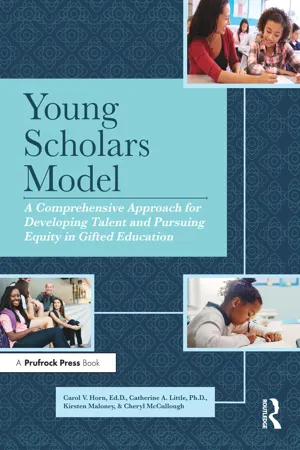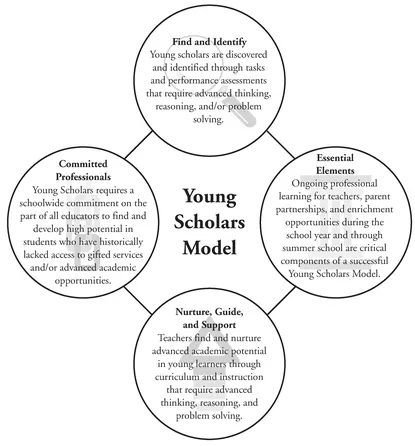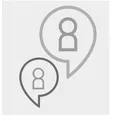
eBook - ePub
Young Scholars Model
A Comprehensive Approach for Developing Talent and Pursuing Equity in Gifted Education
- 250 pages
- English
- ePUB (mobile friendly)
- Available on iOS & Android
eBook - ePub
Young Scholars Model
A Comprehensive Approach for Developing Talent and Pursuing Equity in Gifted Education
About this book
Historically, students from ethnically, linguistically, and economically diverse backgrounds have been overlooked and underidentified for gifted services. The Young Scholars Model is a comprehensive approach to addressing the issue of underrepresentation through engagement of a schoolwide effort and commitment. This book:
- Shares how the model leads to increased representation in identification and student success in advanced academic programs.
- Describes the four major components of the model and how they integrate in practice.
- Supports efforts to find and nurture potential in students who have historically been overlooked for gifted services.
- Includes steps for implementation and practical guidelines that schools and districts will be able to follow with fidelity and success.
Frequently asked questions
Yes, you can cancel anytime from the Subscription tab in your account settings on the Perlego website. Your subscription will stay active until the end of your current billing period. Learn how to cancel your subscription.
No, books cannot be downloaded as external files, such as PDFs, for use outside of Perlego. However, you can download books within the Perlego app for offline reading on mobile or tablet. Learn more here.
Perlego offers two plans: Essential and Complete
- Essential is ideal for learners and professionals who enjoy exploring a wide range of subjects. Access the Essential Library with 800,000+ trusted titles and best-sellers across business, personal growth, and the humanities. Includes unlimited reading time and Standard Read Aloud voice.
- Complete: Perfect for advanced learners and researchers needing full, unrestricted access. Unlock 1.4M+ books across hundreds of subjects, including academic and specialized titles. The Complete Plan also includes advanced features like Premium Read Aloud and Research Assistant.
We are an online textbook subscription service, where you can get access to an entire online library for less than the price of a single book per month. With over 1 million books across 1000+ topics, we’ve got you covered! Learn more here.
Look out for the read-aloud symbol on your next book to see if you can listen to it. The read-aloud tool reads text aloud for you, highlighting the text as it is being read. You can pause it, speed it up and slow it down. Learn more here.
Yes! You can use the Perlego app on both iOS or Android devices to read anytime, anywhere — even offline. Perfect for commutes or when you’re on the go.
Please note we cannot support devices running on iOS 13 and Android 7 or earlier. Learn more about using the app.
Please note we cannot support devices running on iOS 13 and Android 7 or earlier. Learn more about using the app.
Yes, you can access Young Scholars Model by Carol V. Horn,Catherine A. Little,Kirsten Maloney,Cheryl McCullough,Carol Horn,Catherine Little in PDF and/or ePUB format, as well as other popular books in Education & Education General. We have over one million books available in our catalogue for you to explore.
Information
Chapter 1
Background and Overview of the Young Scholars Model
DOI: 10.4324/9781003239697-2
If you treat an individual as he is, he will remain how he is. But if you treat him as if he were what he ought to be and could be, he will become what he ought to be and could be.
—Johann Wolfgang von Goethe
The Young Scholars Model is grounded in a belief system that necessitates a major paradigm shift in the notion of giftedness. The following statements capture the core beliefs that underlie the foundation of the model. Each chapter begins with a set of beliefs that elaborate on these statements and that underlie the work of the educators engaged in implementing the model.
We believe . . .
- • Exceptional talent and academic ability exist in all populations.
- • Implementation of the Young Scholars Model requires a community of professionals working together with a shared commitment to find and develop talent in all children.
- • Ongoing assessment by educators who have been trained to provide curriculum and instruction that are designed to elicit gifted behaviors may be the most powerful means of finding and nurturing gifted learners from underrepresented populations.
- • High-level curriculum and instruction infused with gifted education pedagogy are an integral part of both finding and nurturing advanced potential in students from historically underrepresented groups.
- • Ongoing professional learning efforts on multiple levels (i.e., district leaders, school administrators, and school staff) are critical to the success of the model. These include a focus on talent development, cultural proficiency, performance assessments, and the development of a growth mindset.
- • Providing access to accelerated programs and enrichment resources is crucial for students who may not otherwise have access due to financial constraints or other obstacles beyond their control. Such programs and resources may include summer school, afterschool activities, field trips, and/or weekend programs through the school district or university partnerships.
- • Building parent partnerships and family relationships is essential. Schools that implement the Young Scholars Model actively work to strengthen parent and family connections.
In this chapter . . .
- • We explain the rationale for the Young Scholars Model.
- • We share the historical context in which the model evolved.
- • We outline the goals and major components of the model.
- • We share voices from the field of educators and students who have had direct experience with the model.
Rationale for the Model
The underrepresentation of students from culturally, economically, and linguistically diverse backgrounds in gifted and talented programs across the United States is one of the most critical equity problems facing public educators today (Peters et al., 2019; Wells, 2020). Underrepresentation means that learners are denied access to learning experiences that are appropriately challenging for their needs, and that their long-term opportunities for accessing advanced learning are limited as well. Research suggests that students from diverse cultural, linguistic, and economic backgrounds tend to be identified for gifted programs and advanced learning opportunities at rates lower than their peers at the elementary level (Olszewski-Kubilius & Corwith, 2018). There are many contributing factors, including limited or inconsistent teacher referrals, an overemphasis on test scores, and/or low expectations (Ford, 2010; Peters et al., 2019). Consequently, as they progress through school, they continue to be underrepresented in honors classes, Advanced Placement (AP) courses, accelerated learning, and higher education opportunities (Hodges et al., 2018). These are components and contributing factors to the excellence gap, which is the term for the disparity between demographic groups in advanced levels of performance in education (Plucker & Peters, 2016).
In response to the ongoing underrepresentation of students from diverse groups in advanced learning programs, two major questions must be addressed, centering on the concepts of equity and excellence:
- • How do educators ensure that every student with gifted potential has equal access to gifted services and advanced academic opportunities?
- • How can gifted programs be more inclusive without compromising high standards?
On the issue of equity, some might dismiss all programs for the gifted as being elitist and serving the needs of only a privileged few. Others would advocate for excellence, believing that students with high ability need gifted services to progress at a rate that is commensurate with their advanced capacity to think, reason, and learn. Through our work and research we have discovered that there are many more students who are able to participate and succeed in curricular experiences that were once reserved for a small identified group of gifted learners. We have also learned that by using curriculum and instruction that is research-based and specifically designed for gifted learners, teachers are able to include more students while maintaining high standards.
Although research suggests that biased identification procedures (e.g., a reliance on tests that require verbal and mathematical proficiency) and/or limited teacher referrals are major causes of the underrepresentation of gifted learners from diverse cultural, linguistic, and economic backgrounds (Bernal, 2002; Castellano & Díaz, 2001), there is a dearth of viable solutions and programs documenting recommendations and actions that may be taken to remedy the situation (Donovan & Cross, 2002; Hodges et al., 2018).
Studies have shown that students from underrepresented populations who have the potential to succeed in advanced academic programs but never gain access are more likely to drop out of school and less likely to pursue higher education (Ford et al., 2002; Scott et al., 1996). For students from traditionally underserved cultural, socioeconomic, and linguistic backgrounds, low teacher expectations and academic labeling that may narrow their options often affect the goals that they set for themselves and lead to disengagement from school. These students often receive more of a rote learning and skills-based approach that does little or nothing to develop their exceptional potential (Olszewski-Kubilius & Thomson, 2010; Smith et al., 1997). Teachers may view students from diverse backgrounds as unable or unwilling to engage in higher level thinking and may even have concerns that these students will hold back the high achievers if placed in the same classrooms (Olszewski-Kubilius & Corwith, 2018).
Many studies focus on the struggles or perceived deficits of children from underrepresented populations rather than on areas of strength that can be nurtured and developed (Ford et al., 2002; Plucker et al., 2010). Traditionally the label “underachiever” is given to a student who achieves high scores on standardized tests but does not perform well in school. However, according to Ford (2010), there is another population of underachievers who have never had an opportunity to achieve at a high level. These are the students from diverse backgrounds who may score poorly on standardized ability tests and yet have the capacity to perform at a high level if given the opportunity. For these students, low achievement becomes a self-fulfilling prophecy that must be changed in two directions. Not only must teachers believe that the students can work at a high level, but also the students must believe they can do the work; such belief emerges through participation in educational experiences designed to challenge their minds and expand their horizons (Ford, 2010; Ford et al., 2002). Further, it is important for these kinds of interventions to begin early in the school years and to be sustained across time to prevent relative slowing of learning rates for some populations of learners as they progress (Rambo-Hernandez et al., 2019).
Although there are many recommendations around the need to address the underrepresentation of students from diverse backgrounds in gifted education programs, few studies evaluate significant efforts, recommendations, and/or programs that are being implemented to solve this problem (Donovan & Cross, 2002; Ford, 2010).
Origins of the Young Scholars Model
A growing concern with the continuous underrepresentation of Black and Hispanic students, students from backgrounds of poverty, and English language learners (ELLs) in gifted programs led the gifted and talented central office staff in a large east coast school district to take a more comprehensive approach to this issue during the 1999–2000 school year. Previous changes and initiatives to address the problem of underrepresentation tended to focus on identification criteria and the use of multiple forms of data to make decisions. However, these changes did little to increase the participation of underrepresented populations in the gifted and talented programs.
The district’s central office staff decided to create a task force of principals and teachers at schools with high numbers of students from diverse cultural, socioeconomic, and linguistic backgrounds. The task force was charged with finding ways to rethink current practice and to design a comprehensive approach to the issue of underrepresentation. Through reading, research, and conversations the task force determined that attention to identification alone was not enough. The students needed early interventions and access to learning opportunities that developed and elicited higher level thinking, all of which would prepare them for success in advanced coursework. They also needed teachers who believed in their advanced potential and who were willing to advocate for them and nurture their strengths so that their potential would be affirmed and developed.
Working closely with the principals and staff in the identified schools, the task force developed a comprehensive approach to the issue of underrepresentation, which evolved into a model that could be replicated by others. The new model developed by this team of stakeholders was called Young Scholars, and it embraced current thinking and research on best practices for finding and nurturing gifted potential in all populations.
The Young Scholars Model (Figure 1) was initially piloted in 12 schools that had diverse student populations overall but very little diversity in the students who were participating in gifted services. Under the leadership of the school principals, teachers and educational specialists worked together to identify students with gifted potential in kindergarten through grade 2 as young scholars. They used classroom observations, anecdotal records, and portfolios of student work. As students were identified, the team offered them learning opportunities that included summer school and afterschool activities. These were accompanied by professional learning opportunities for the teachers and educational offerings for the parents. The goal was to ensure that every child with an exceptional capacity to learn, reason, and apply knowledge was nurtured at an early age and prepared to participate in formal gifted and talented programs and/or advanced academic courses.

Figure 1
The Young Scholars Model
The Young Scholars Model
Voices From the Field

Growing up in rural Ethiopia, my mother did not receive a formal education. My father fared better and attended school until the eighth grade before dropping out. Although they themselves could not reap the benefits of an education, they knew of its limitless potential. Each year, they applied for a chance to immigrate to the United States to procure an education for their children. That opportunity came and my family moved to America.
When we arrived in Washington, DC, I struggled to adapt to the new culture and language. In second grade, my family was informed that I would be transferring from my base school to a school that had a full-time Advanced Academics Program (AAP). I was able to partake in AAP through the Young Scholars program that selects students from low-income backgrounds to partake in AAP. My first year within the program was arduous because the AAP program was more challenging than my base school. However, by my third year within the program, I was on par with my other peers within the AAP program. By middle school, I had even advanced to the top tier of my cohort. The AAP program gave me a strong foundation for my high school International Baccalaureate (IB) courses in which I excelled. With my success in my courses, and the SAT, I was accepted to seven Ivy League universities (I never applied for the eighth one).
What surprises me the most about [the program I experienced] is its ability to select students with potential. The clamour with gifted and talented programs is that they often select the children of well-connected parents and are not based on meritocracy. My story is the antithesis of that argument. Despite my lack of proficiency in English, the Young Scholars program invested in me because they saw unbridled potential. I can undoubtedly say that without the AAP program, I would not be where I am today. Out of my six siblings, only two have gone on to graduate from college. However, the Young Scholars and AAP program placed me, early on in my life, in a highly nurturing learning environment.
—Yosaph Boku, one of the first young scholars and a recent Harvard graduate
Goals and Components of the Young Scholars Model
The Young Scholars Model has two important goals. The first is to identify talent potential in children from diverse cultural, economic, and linguistic backgrounds as early as possible. The second goal is to nurture, guide, and support the development of the students’ exceptional potential. The emphasis is on seeking students who are showing potential that is exceptional (i.e., atypical) compared to peers of similar age, experience, and background, thus indicating that their academic needs may include more advanced learning opportunities. School districts that have implemented the model have experienced systemic change and a dramatic increase in the number of students from diverse populations receiving gifted services.
In Young Scholars schools, all students are exposed to experiences that are designed to elicit behaviors that may indicate high potential. As this potential emerges, the students who are designated as young scholars are clustered in classrooms with teachers who are trained in gifted education pedagogy. The teachers collaborate, plan, design, and implement learning experiences that connect to the students’ diverse cultural, economic, and linguistic backgrounds. Basic skills are strengthened through lessons that also require students to think and apply knowledge on a higher, more complex level.
It is important to note that, from the beginning, young scholars are held to the same high standards and performance expectations as other advanced learners. The main difference is in the scaffolding and support that is provided to promote and nurture the...
Table of contents
- Cover
- Half Title
- Title Page
- Copyright Page
- Dedication
- Table of Contents
- Acknowledgments
- Foreword
- Introduction
- CHAPTER 1 | Background and Overview of the Young Scholars Model
- CHAPTER 2 | School and District Leadership
- CHAPTER 3 | Seeking and Identifying Potential in Young Scholars
- CHAPTER 4 | High-Quality Curriculum
- CHAPTER 5 | Professional Learning
- CHAPTER 6 | Partnering With Families
- CHAPTER 7 | Enrichment Opportunities
- CHAPTER 8 | Expanding the Young Scholars Model to Other Schools and Districts
- References
- Appendix: Sample Applications of Critical and Creative Thinking Strategies
- About the Authors